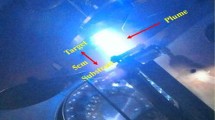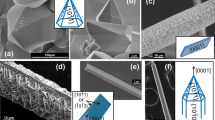Abstract
Effects of Ga doping on the morphology, microstructure, electron density distribution, and optical properties of hydrothermally grown ZnO nanostructures have been studied by means of scanning electron microscopy, diffuse reflectance spectroscopy, X-ray diffraction, and the maximum entropy methods. It has been shown that while Ga incorporation in ZnO lattice does not result in a large distortion of its wurtzite structure, it affects substantially the electronic charge distribution along the Zn–O bonds. Anisotropic redistribution of the electron charge density around the cation sites consolidates the assumption that the Ga atoms in doped nanostructures incorporate by substituting Zn atoms. The formation of a high density of point defects modifies the lattice dynamics of ZnO; in addition, it introduces a pronounced band-tail in the forbidden band gap.








Similar content being viewed by others
References
Hong CS, Park HH, Moon J, Park HH (2006) Effect of metal (Al, Ga, and In)-dopants and/or Ag-nanoparticles on the optical and electrical properties of ZnO thin films. Thin Solid Films 515:957–960
Bethke S, Pan H, Wessels B (1988) Luminescence of heteroepitaxial zinc oxide. Appl Phys Lett 52:138–140
Choopun S, Vispute RD, Woch W, Balsamo A, Sharma RP, Venkatesan T, Iliadis A, Look DC (1999) Oxygen Pressure-tuned epitaxy and optoelectronic properties of laser-deposited ZnO films on sapphire. Appl Phys Lett 75:3947–3949
Wenas WW, Yamada A, Takahashi K, Yoshino M, Konagai M (1991) Electrical and optical properties of boron-doped ZnO thin films for solar cells grown by metal organic chemical vapor deposition. J Appl Phys 70:7119–7123
Agura H, Suzuki A, Matsushita T, Aoki T, Okuda M (2003) Low resistivity transparent conducting Al-doped ZnO films prepared by pulsed laser deposition. Thin Solid Films 445:263–267
Ko HJ, Chen YF, Hong SK, Wenisch H, Yao T, Look DC (2000) Ga-doped ZnO films grown on GaN templates by plasma-assisted molecular-beam epitaxy. Appl Phys Lett 77:3761–3763
Hu J, Gordon RG (1993) Electrical and optical properties of indium doped zinc oxide films prepared by atmospheric pressure chemical vapor deposition. Mater Res Soc Symp Proc 283:891–896
Minami T (2005) Transparent conducting oxide semiconductors for transparent electrodes. Semicond Sci Technol 20:S35–S44
Gabás M, Landa-Cánovas A, Costa-Krämer J, Agulló-Rueda F, González-Elipe AR, Díaz-Carrascp P, Hernández-Moro J, Lorite I, Herrero P, Castillero P, Barranco A, Ramon Ramos-Barrado J (2013) Differences in n-type doping efficiency between Al– and Ga–ZnO films. J Appl Phys 113:9–163709
Xu C, Kim M, Chun J, Kim D (2005) Growth of Ga-doped ZnO nanowires by two-step vapor phase method. Appl Phys Lett 86:3–133107
Özgür Ü, Hofstetter D, Morkoc H (2010) ZnO devices and applications: a review of current status and future prospects. Proc IEEE 98:1255–1268
Ahmad M, Zhu J (2011) ZnO based advanced functional nanostructures: synthesis, properties and applications. J Mater Chem 21:599–614
Djurišić AB, Chen XY, Leung YH, Ng AMC (2012) ZnO nanostructures: growth, properties and applications. J Mater Chem 22:6526–6535
Rietveld HM (1969) A profile refinement method for nuclear and magnetic structures. J Appl Crystallogr 2:65–71
McCusker LB, Von Dreele RB, Cox DE, Loüer D, Scardi P (1999) Rietveld refinement guidelines. J Appl Crystallogr 32:36–50
Kumazawa S, Kubota Y, Takata M, Sakata M, Ishibashi Y (1993) MEED: a program package for electron density distribution calculation by the maximum entropy method. J Appl Crystallogr 26:453–457
Pineda-Hernandez G, Escobedo-Morales A, Pal U, Chigo-Anota E (2012) Morphology evolution of hydrothermally grown ZnO nanostructures on gallium doping and their defect structures. Mater Chem Phys 135:810–817
West AR (1984) Solid state chemistry and its applications. Wiley, Great Britain
ICDD (1997) Joint committee powder diffraction standards, Card No. 36-1451, version 1.30, Database of the international center for diffraction data, 12, campus boulevard, Newton square, Pennsylvania, 19073-3273, USA
Yoon MH, Lee SH, Park HL, Kim HK, Jang MS (2002) Solid solubility limits of Ga and Al in ZnO. J Mater Sci Lett 21:1703–1704
Wang R, Sleight AW, Cleary D (1996) High conductivity in Ga doped ZnO powders. Chem Mater 8:433–439
Petříček V, Dušek M, Palatinus L (2006) Jana 2006: The crystallographic computing system. Institute of Physics, Praha
Hahn T (2005) International tables for crystallography. Space group symmetry, vol A. Springer, The Netherlands
Özgür Ü, Alivov YI, Liu C, Teke A, Reshchikov MA, Dogan S, Avrutin V, Cho SJ, Morkoc H (2005) A comprehensive review of ZnO materials and devices. J Appl Phys 98:103–041301
Sheu JK, Shu KW, Lee ML, Tun CJ, Chi GC (2007) Effect of thermal annealing on Ga-doped ZnO films prepared by magnetron sputtering. J Electrochem Soc 154:H521–H524
Saravanan R (2008) Grain software. Private communication
Guinier A (1994) X-ray diffraction in crystals, imperfect crystals and amorphous bodies. Dover Publications, New York
Izumi F, Dilanian RA (2002) Recent research developments in physics, Part II, vol 3. Transworld Research Network, Trivandrum
Momma K, Izumi F (2011) VESTA 3 for three-dimensional visualization of crystal, volumetric and morphology data. J Appl Crystallogr 44:1272–1276
Hardcastle FD, Wachs IE (1991) Determination of vanadium–oxygen bond distances and bond orders by Raman spectroscopy. J Phys Chem 95:5031–5041
Dong S, Padmakumar R, Banerjee R, Spiro TG (1996) Resonance Raman Co–C stretching frequencies reflect bond strength changes in alkyl cobalamins, but are unaffected by trans-ligand substitution. J Am Chem Soc 118:9182–9183
Bundesmann C, Ashkenov N, Schubert M, Spemann D, Butz T, Kaidashev EM, Lorenz M, Grundmann M (2003) Raman scattering in ZnO thin films doped with Fe, Sb, Al, Ga and Li. Appl Phys Lett 83:1974–1976
Wang X, Xu J, Yu X, Xue K, Yu J, Zhao X (2007) Structural evidence of secondary phase segregation from the Raman vibrational modes in Zn1−xCoxO (0 < x < 0.6). Appl Phys Lett 91:3–031908
Windisch CF, Exarhos GJ, Owings RR (2004) Vibrational spectroscopic study of the site occupancy distribution of cations in nickel cobalt oxides. J Appl Phys 95:5435–5442
Holland TJB, Redfern SAT (1997) Unit cell refinement from powder diffraction data: the use of regression diagnostics. Mineral Mag 61:65–77
Escobedo-Morales A, Sánchez Mora E, Pal U (2007) Use of diffuse reflectance spectroscopy for optical characterization of un-supported nanostructures. Rev Mex Fis S53:18–22
Halperin BI, Lax M (1966) Impurity-band tails in the high-density limit. I. Minimum counting methods. Phys Rev 148:722–740
Burstein E (1954) Anomalous optical absorption limit in InSb. Phys Rev 93:632–633
Moss TS (1954) The interpretation of the properties of indium antimonide. Proc Phys Soc London B 76:775–782
Wang R, King LLH, Sleight AW (1996) Highly conducting transparent thin films based on zinc oxide. J Mater Res 11:1659–1664
Iribarren A, Castro-Rodríguez R, Sosa V, Peña JL (1998) Band-tail parameter modeling in semiconductor materials. Phys Rev B 58:1907–1911
Acknowledgements
This work was supported by the CONACyT, Mexico (Grants# CB-2010/151767 & CB-2011/168027) and VIEP-BUAP. The authors are also grateful to the Madura College, Tamil Nadu, India and SAIF, Cochin University, India for extending their experimental facilities.
Author information
Authors and Affiliations
Corresponding author
Rights and permissions
About this article
Cite this article
Saravanakumar, S., Escobedo-Morales, A., Pal, U. et al. Doping-induced electron density modification at lattice sites of ZnO:Ga nanostructures: effects on vibrational and optical properties. J Mater Sci 49, 5529–5536 (2014). https://doi.org/10.1007/s10853-014-8242-z
Received:
Accepted:
Published:
Issue Date:
DOI: https://doi.org/10.1007/s10853-014-8242-z




